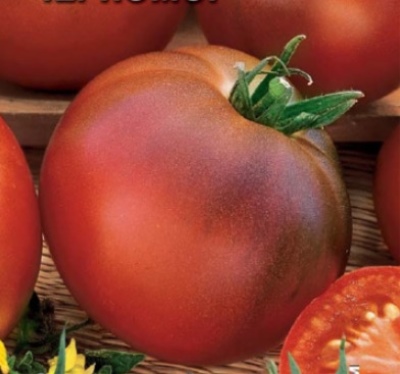
- Authors: Kondratyeva I.Yu., Kandoba E.E.
- Year of approval: 2007
- Category: grade
- Growth type: determinant
- Appointment: fresh consumption
- Ripening period: mid-season
- Ripening time, days: 105-110
- Growing conditions: for open ground
- Marketable fruit yield,%: 73%
- Bush size: medium-sized
Dark-fruited tomato varieties are becoming more and more popular among gardeners and farmers. One of the most popular is the Chernomor tomato, which is productive both in the garden bed and in the greenhouse.
Breeding history
This exotic tomato variety was created by Russian breeders (I. Yu. Kondratyeva and E. E. Kandoba) in 2004, joined the ranks of the State Register for the Russian Federation, and was also approved for use in 2007. The tomato is zoned in the middle lane and the Chernozem region (Belgorod, Lipetsk, Moscow, Kursk, Tambov and Voronezh regions). It is possible to grow a vegetable crop both in the beds and in greenhouse conditions, but the maximum productivity was found in protected ground.
Description of the variety
Chernomor is a medium-sized shrub with a determinant type of growth, reaching a height of 130-150 cm. The plant is characterized by moderate thickening of green foliage, a strong central stem, medium branching, a developed root and simple inflorescences. 3-5 berries are formed in each fruit cluster.
When planting Chernomor tomato bushes, do not forget about the formation of 2-3 stems, which helps to increase yields, regular removal of stepchildren who take away vital energy, and the obligatory garter to powerful supports.
The fruits have a universal purpose, so they are eaten fresh, added to salads and other dishes, processed into juices and dressings, and canned whole (the smallest berries).
The main qualities of the fruit
The Chernomor tomato produces fruits of medium and large sizes - from 150-180 g to giant tomatoes weighing 250-300 grams. The shape of the fruit is flat, rounded with a slight ribbing of the surface. An unripe vegetable has a green color with a dark speck at the stalk. As it ripens, the vegetable changes color several times - from purple to deep red. The skin of the fruit is dense, shiny, but not hard. The tomato is characterized by resistance to cracking, long-term keeping quality and transportability. Only tomatoes overexposed on the bushes can crack.
Taste characteristics
Tomatoes taste good, balanced. The flesh of the vegetable is fleshy, dense and juicy. There are very few seeds in the pulp. The taste is dominated by dessert sweetness, harmoniously combined with a spicy tomato aroma. The peculiar taste is due to the sugar content of the fruit. Tomato pulp is high in vitamin A, lycopene and antioxidants.
Ripening and fruiting
The variety is mid-season, so it takes 105-110 days from the appearance of mass shoots to ripe berries on the bushes. Tomatoes ripen gradually, so you can enjoy their fresh taste and aroma from 4 to 8 weeks. The peak of active fruiting occurs in July-August.
Yield
The yield of the variety is very high. With proper care, one bush can produce up to 50 ripe tomatoes per season. On an industrial scale, yield indicators are also high - from 184 to 506 c / ha.
The timing of planting seedlings and planting in the ground
Chernomor tomatoes are grown through seedlings. Sowing seeds is recommended after March 15th. Germination occurs in 5-7 days. The greenhouse effect (glass or polyethylene is used) will help speed up the process of sprouting. For the growth of seedlings, favorable conditions should be provided - a temperature regime (20-24 degrees) and a sufficient amount of light.At the stage of the appearance of several leaves, the bushes can be seated in separate cups. After the pick, mineral fertilizers are applied.
At the age of 60-65 days, the bushes can be transplanted to a permanent place of growth. A week before, the plants are prepared - hardened, exposing them to fresh air every day. Landing on the garden bed is carried out at the end of May, and in the greenhouse - in the first half of the month.

Growing tomato seedlings is an extremely important process, because it largely depends on whether the gardener can harvest at all. All aspects must be taken into account, from seedbed preparation to planting in the ground.
Landing scheme
Maintaining the density and planting pattern of tomatoes is just as important as ensuring proper care. No more than 4 bushes can be placed per 1 m2. The optimal layout for planting is 40x60 cm.

Growing and care
The tomato is not capricious to care for, but it has a number of requirements for the soil. The soil should be loose, moisture and air permeable, fertile and with neutral acidity. There should be plenty of sunlight in the area with planted tomatoes. Plant care consists of a set of measures: watering at the root (a drip system is suitable), feeding, weeding the soil, shaping, pinching and tying bushes, ventilating the greenhouse and protecting against diseases.




A plant needs different micronutrients at each stage of growth. All fertilizers can be divided into two groups: mineral and organic. Folk remedies are often used: iodine, yeast, bird droppings, eggshells.
It is important to observe the rate and period of feeding. This also applies to folk remedies and organic fertilizers.
Disease and pest resistance
The crop has good immunity, so it is resistant to many common nightshade diseases. The only thing a tomato has a weak resistance to is late blight.


Resistant to adverse weather conditions
The variety has excellent resistance to stress. It is cold-resistant, easily tolerates drought and heat, as well as temperature extremes. Does not like tomato long-term shade and drafts. In addition, humidity control is recommended.

























































































